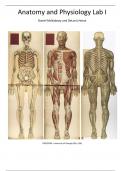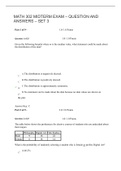Anatomy and Physiology Lab I
Daniel McNabney and DeLoris Hesse
CBIO2200L, University of Georgia (GA, USA)
,Previous page photo credit
Bouglé, Julien. Le corps humain en grandeur naturelle : planches coloriées et superposées, avec texte
explicatif. Paris : J. B. Baillière et fils, 1899. 1 plate : col. ill.
Source: U.S. National Library of Medicine.
http://www.nlm.nih.gov/exhibition/historicalanatomies/bougle_home.html
Introduction
This laboratory manual was written in 2019 via an OER Revisions and Ancillary Materials Creation Mini-Grant
from Affordable Learning Georgia (affordablelearninggeorgia.org). The goal of the project is to create an open
educational resource lab manual that provides students in our first-semester large introductory Anatomy and
Physiology laboratory course (CBIO2200L) at the University of Georgia (GA, USA) with a tailored, low-cost set
of course materials.
CBIO2200L covers the structure and function of several of the body’s systems including: cells, tissues, the
integumentary system, skeletal system, muscular system, and nervous system. Emphasis is placed on humans
with some comparison to other mammals. The overall goal of CBIO2200L is to gain a foundational
understanding of the normal structure and function of the above systems of the human body, not an in-depth
analysis of any single part or system. The laboratory component is a required and important part of the overall
course and labs both introduce new course material and reinforce topics discussed in lecture. Labs include the
identification of structures on a variety of available resources (models, preserved specimens, and human
cadavers) and demonstration of physiological concepts through lab activities.
Source and Companion Materials
Each lesson contains specific citations used during the creation of course materials. The following sources
played a major role in the development of this lab manual:
• The majority of background information is a derivative of "Anatomy and Physiology" by OpenStax CNX
used under CC BY 4.0. Aug 2, 2019. Access for free at https://openstax.org/books/anatomy-and-
physiology/pages/1-introduction
• Histological resources and a virtual microscope via the University of Michigan Medical School:
https://histology.medicine.umich.edu/
• The lessons found within this document were uploaded into the digital learning platform, Lt by
ADInstruments (https://www.adinstruments.com/lt). Lt is a browser-based learning platform that
allows our students to interact with the course materials via lab activities that are not possible with a
traditional paper lab manual (ex: photo and video activities, interactive question sets, etc.). Lt also
allows our students to collect, analyze, and present human physiological data via PowerLab data
acquisition systems (https://www.adinstruments.com/products/powerlab).
Acknowledgements
We would like to thank the following people for their help and support during this project: Gabriella
Sandberg, Aimee Williams, Manashree Malpe, Nurgul Kaya, Lindsey Beebe, Angie Holliday, Ann Massey, Rob
Nichols, Kojo Mensa-Wilmot, Robin Fowler, Beverly Martin, Fall 2019 CBIO2200L TAs, Fall 2019 CBIO2200L
students.
,Table of Contents
1. Introduction to Anatomy & Physiology
2. Cells
3. Histology – Epithelial & Connective Tissues
4. Histology – Muscle & Nervous Tissues
5. The Integumentary System
6. Introduction to the Skeletal System
7. Introduction Joints
8. The Lower Limb – Bones
9. The Lower Limb – Muscles
10. The Lower Limb – Joints
11. The Lower Limb – Nerves
12. The Lower Limb – Movement
13. The Upper Limb – Bones
14. The Upper Limb – Muscles
15. The Upper Limb – Joints
16. The Upper Limb – Nerves
17. The Upper Limb – Movement
18. Muscle Physiology
19. Axial Skeleton
20. Axial Musculature
21. Intervertebral Discs
22. Central Nervous System – The Spinal Cord
23. Central Nervous System – The Brain
24. Motor Control
25. The Senses – Vision
26. The Senses - Hearing
, Lesson 1: Introduction to Anatomy & Physiology
Created by Dan McNabney
Introduction
In this lesson you will review the basic organization scheme of the human body and start to develop the
language commonly used to precisely describe the location of structures of the human body.
Student learning outcomes (SLOs):
By the end of this lesson you will be able to:
1. Describe the hierarchy of organization of the human body
2. Demonstrate and describe anatomical position
3. Use directional terms to precisely describe the location of structures on the human body
4. Demonstrate and describe anatomical planes of section
5. Identify the major body cavities and provide examples of major organs found in each





